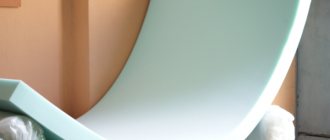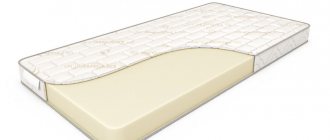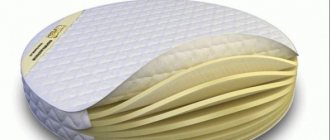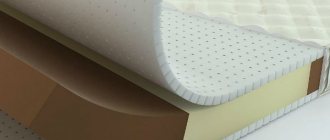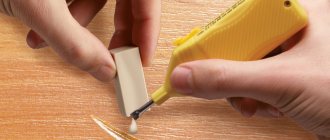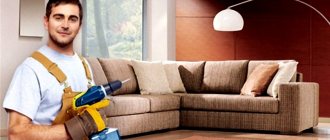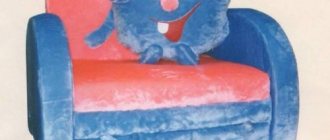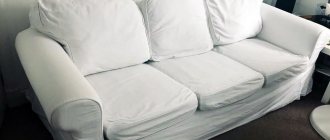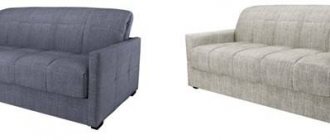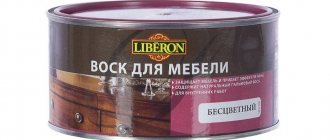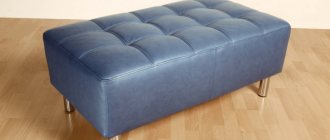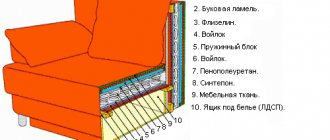- The use of foam rubber in furniture production
- Shapes and sizes of foam rubber
- Foam rubber brands
- What density is furniture foam?
- What type of foam should I use for a sofa or upholstered furniture?
- Memo for choosing foam rubber
- Marking of foam rubber, GOST
Foam rubber is polyurethane foam (polyurethane foam, polyurethane foam). This material is 90% air. The foam is soft and holds its shape well. First obtained in the laboratory in 1941.
Shapes and sizes of foam rubber
- Sheet
- Figured
- Roll
- Blocky
The most popular is sheet with a size of 1 by 2 meters. Forms of furniture foam rubber are in demand on the market according to the order given in the list. Sheet is used on flat surfaces and to fit shapes. Figured, most often round, to give individual elements cylindrical shapes. Rolled is very similar to sheet, but thin foam rubber is usually wound into the roll. Block foam rubber is a sheet with a large thickness, from which an individual shape can be cut for further use in the product.
Types of furniture foam rubber
When choosing upholstered furniture for your home, it is very important to pay attention to its comfort. It would be a good idea to ask which filler the manufacturer chose for the manufacture of a particular model. A wide variety of brands can confuse an inexperienced specialist, let alone an ordinary buyer. The selection criteria are density and thickness.
REFERENCE. To assemble upholstered furniture, it is necessary to use material with a density of 30 kg per cubic meter. m. Such sofas can be used both for sleeping and for relaxing while sitting. During operation, the filler is not pressed through.
IMPORTANT. The duration of use of the furniture will depend on the density of the foam rubber. The dependence works - the higher the density, the longer the period of operation.
For the manufacture of furniture seats and armrests, a material with different characteristics is used, this is explained by different degrees of load.
Thickness is an equally important indicator. If we are talking about a sofa for sleeping, the thickness should be at least 4 cm. Furniture manufacturers often neglect this criterion and use thin foam rubber, which significantly reduces the quality of the furniture.
Quality indicators
When choosing foam rubber, you must first of all pay attention to its main parameters: thickness and density. The quality and scope of application of this material are influenced by the following qualities:
- Filler density. The higher this indicator, the longer the material will last.
- Compressive stress. The standard kPa value should be 40% in the compressed state.
- Fortress. This indicator is determined by rupture and elongation during the rupture process.
- Elasticity. This indicator is determined based on the rebound height at the time of testing.
- Residual deformation. After the load is removed, the surface should return to its original shape as quickly as possible. The dependence works here - the higher the density of the material, the less susceptible it is to deformation.
REFERENCE. Manufacturers indicate letters in the name of foam rubber that allow you to quickly determine its class. The numbers indicated in the name will help determine the density and compression stress.
What type of foam should I use for a sofa or upholstered furniture?
Not everyone understands what type of foam rubber is best used and for what purposes.
If we disassemble the sofa into its components, we will see foam rubber on the back, armrests, seat, sides and drawer. Let's look at several options for choosing the right foam rubber.
Often a sofa is used as a sleeping place, in this case we recommend brand foam rubber (EL) with a density of 25-30 kg/m3.
For children's and guest furniture, you can use foam rubber (ST) with a density of 20-25 kg/m3.
Soft grades (S) and extra soft grades (HS) are better suited for the manufacture of decorative pillows and backs of sofas that are not used as a sleeping place and at the same time they are not exposed to such frequent exposure.
For public spaces and for the production of luxury furniture, we recommend using highly elastic foam rubber (HR) with a density of 35-55 kg/m3.
Hard or hard foam rubber (HL) can withstand up to 100 kg; it is best used in products with increased load.
Rules for the use and combination of materials
When making furniture, types of foam rubber are combined. One product can combine dense and soft polyurethane foam with different comfort levels. Before choosing furniture foam rubber, you should take into account the purpose and operating conditions of the products:
- Sofa-sofa and sofa-book. Sleeping place - ST3542/EL2842, backrest - EL2540.
- The decorative headboard of the soft bed is EL2240, the remaining elements are EL2842/ST3542.
- Corner sofa. Backrest - ST3542, berth - EL2842/ST3542.
- Armchairs, chairs - EL2842/ST3542.
- Kitchen corner - EL2842/ST3542.
- Mattress - EL2842/ST3542 + coconut coir + felt layer.
The best fabrics, designs for oversized furniture covers, nuances of choice
Foam rubber is used not only for making furniture, but also for its restoration. Polyurethane foam goes well with padding polyester. The latter prevents the filler from sticking to the fabric, smoothes out minor irregularities on its surface, making the furniture even more comfortable and convenient, extending its service life.
To make soft, elastic poufs and seats, foam rubber with latex is used.
Memo for choosing foam rubber
Extra Soft (HS) and Soft (S) are considered the most flexible of all varieties. With their help, maximum comfort is achieved.
Standard (ST) – base material with an optimal ratio of rigidity and elasticity.
Hard (EL) – used for the manufacture of sleeping places for sofas and mattresses. Withstands heavy loads.
High-hardness (HL) - used for the manufacture of furniture elements designed for increased load, as well as high-hardness mattresses.
Highly elastic (HR) – has high comfortable properties, increased elasticity and creates a spring effect without sagging. It is recommended to use for the manufacture of load-bearing parts of furniture.
How to replace it yourself: instructions
Tools and materials to change
To replace the foam rubber in the sofa you will need the following tools:
- set of wrenches;
- scissors for cutting material;
- side cutters, nippers;
- construction stapler;
- sewing machine;
- strong threads;
- accessories for decorating pillows (buttons, appliqués).
The best material is tapestry. It looks great and can be combined with other fabrics and textiles in the interior. Can be cleaned with any detergent without damaging the appearance.
For home upholstery the following are most often selected:
- flock;
- velours;
- jacquard.
Any type of fabric looks very elegant, even elegant, on the sofa.
Faux leather, if foam rubber is chosen, will not work. This is due to the fact that it is difficult to tighten it evenly on your own; it is better to entrust the work to the masters.
This article tells you what material is best to choose for upholstery and how to cover a sofa yourself.
Laying order: how to lay it?
Stages of work:
- All pillows, blankets, and decor are removed from the sofa. Then they begin to inspect the casing. It is necessary to turn the sofa so that it is convenient to inspect the frame. It is important to identify all wooden parts for fractures and rot.
- If the upholstery needs to be replaced, it is done immediately after the inspection. To do this, take fabric identical to the old coating. The frame is replaced by using special plywood and screws that will be suitable for working with the material.
- Carefully check the areas under the pillows. If the platform between them is broken, then make a support.
AdviceIn hardware stores you can purchase a special ready-made support (usually made of fiberboard or higher quality materials, depending on the manufacturer).
- You can additionally purchase thin plywood, which will completely match the size of the pillows, and lay it under them so that there is no squeezing under increased load.
- The integrity of the springs is an important test step. If they are bent or bent, they must be straightened and put in place with pliers. If the springs have become completely unusable, then they need to be replaced with new ones.
- Then check all the pillows one by one. The reason for the sinking of the sofa may also lie in them. If the sofa is too soft (whether such softness is initially upon purchase or after long-term use of the sofa), it is necessary to add a similar filler to the upper or lower parts and lay a foam seal.
- The frame and the back are strengthened with strong tape.
How to secure?
You can take out the old filler and use it to pattern a new one. Before fixing the layer, you need to carefully measure and cut out all the necessary elements according to the pattern.
The upholstery should fit tightly and beautifully. To do this, you need to firmly press it into the foam rubber at the places where the upholstery is attached to the base. In this case, this will help straighten the material and add elasticity.
The fabric should be stretched tightly with a construction stapler. The staples should be on the underside of existing parts. You cannot get into the joints and contact areas of individual parts - you can snag the upholstery and ruin its appearance. You need to pull the fabric tightly and secure it with a construction stapler.
Important
The staples should be located on the underside of the parts. There should be no overlap at the joints and adjacent parts to prevent damage to the upholstery and make it impossible to completely fold the sofa in the desired direction.
Assembly
Assembly is performed in reverse order. All elements are placed in place. You need to remember the disassembly steps in order to reassemble everything correctly. You can record the process on camera.
The cut filler should fit snugly against the wooden base of each piece. At this stage, you can add volume to the back and armrests due to a thicker layer of filler. The larger the size of the canvas, the more you will need to stretch and distribute the fabric along the edges.
The sides and back are assembled differently than the main middle part. A softer foam would be suitable here. These protruding elements are not subject to excessive stress and can easily be done without increased attention to them. If there is a spring block at the base, then a layer of tightly fixed fabric is placed on it (what if the spring block breaks?).
To do the job well, it is advisable to have canvas. You can take similar any other fabric. Every detail must be covered. Then the sofa or bed is assembled to the condition in which it was originally before disassembly.
Marking of foam rubber according to GOST
Often the name contains a disclosure of all the main characteristics. Let’s look at an example of one of the most popular items of furniture foam rubber – “EL-2535 100mm”. EL is a brand; 25 – density of foam rubber is measured in kg/m3; 35 – foam hardness is measured in kPa and shows how much pressure is required to compress the material by 40%; 100mm – foam thickness. In most cases, the name is already enough to select foam rubber.
You can select the desired foam rubber in the PPU catalog, as well as glue for foam rubber in our online store.
Material care
Improper use leads to deformation and thinning of the material. Rules of care:
- do not keep close to heating devices or fireplaces;
- do not iron (except for heat-resistant brands);
- Can be dry cleaned, hand washed or machine washed.
Heavy contamination is pre-treated:
- soap;
- washing powder solution;
- dishwashing gel.
The detergent is foamed, applied to the stain, and left for 30 minutes. Then they start washing.
How to wash foam rubber in a washing machine:
- temperature not higher than +40 °C;
- do not bend the product;
- use liquid detergent;
- turn off drying;
- number of revolutions – no more than 800.
When washing by hand, the same rules are followed, but you can use washing powder after completely dissolving it in water. Afterwards, the material is rinsed 2-3 times and the soapy water is allowed to drain.
The material is carefully squeezed out without using force. Air dry or lay out on a flat surface. You can place a towel or cotton cloth - they will absorb some of the water. You cannot dry it on a radiator - the item will become deformed.
Foam accessories for the bed are washed as follows:
- pillows - in the washing machine if they fit into the drum or by hand;
- mattress - by hand;
- blanket - by hand.
Furniture, car seats, or toys may require repairs. At home, foam rubber can be glued to fabric using glue:
- "BF-6". It is safe, but requires application in 2 layers and preliminary wetting of surfaces.
- "Rapid". Does not burn, sets quickly, forms a strong seam.
- "Foam 88". Old glue on rubber, a thin layer is enough for connection.
- "Foam rubber 2". It is used in furniture production and holds parts well.
- "Olimpur". It is applied pointwise and is water-based.
- "Crystal Moment" Available for purchase, the weld strength is medium-high.
Purpose of brands of furniture foam rubber
There is a certain classification of foam rubber, on its basis you can determine what material is intended for what purpose. First of all, you should understand the brand designation. Manufacturers use Latin letters:
- ST is the most common material, standard type.
- HL and EL - this material already belongs to the rigid type, the second option is of increased rigidity.
- HS is a soft or ultra-soft material. Quite often used in sofas.
- HR is a designation for highly elastic material.
- LR - this material will be soft and viscous in structure.
- RTC is a reticulated polyurethane foam with increased porosity.
Designation in Latin letters is only part of the encrypted characteristics. There are also numbers. The initial numbers indicate the density of the foam, and the other two indicate the compressive stress.
Just based on the markings, you can understand which material is suitable for what purposes.
